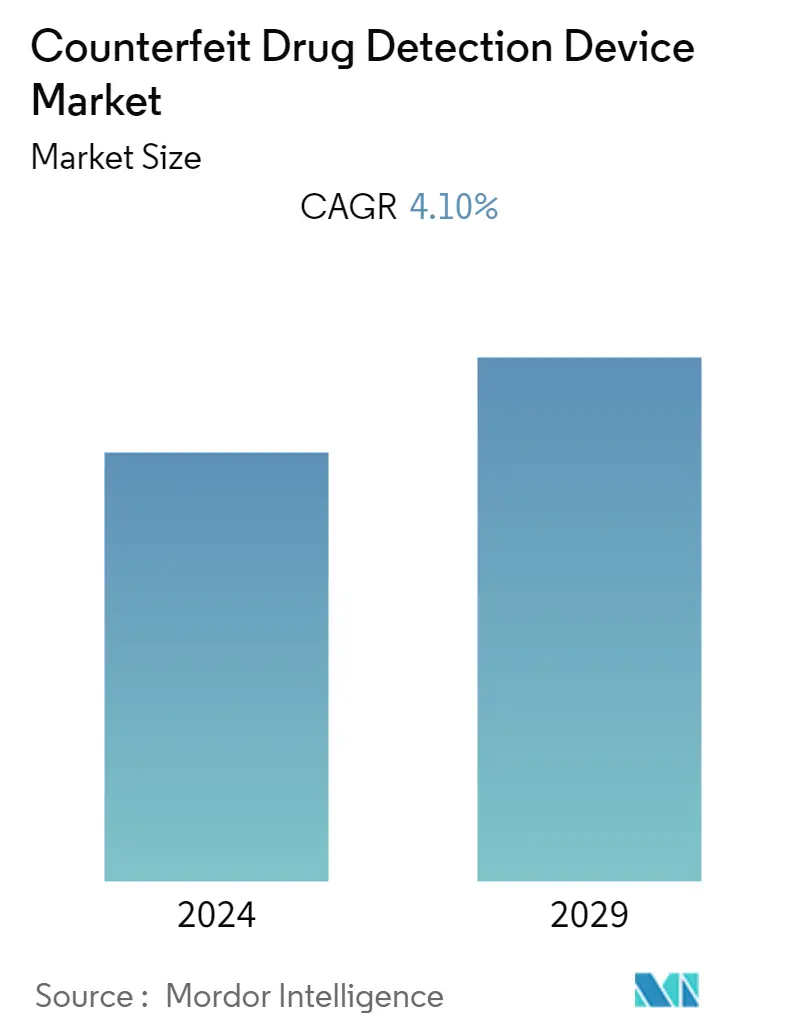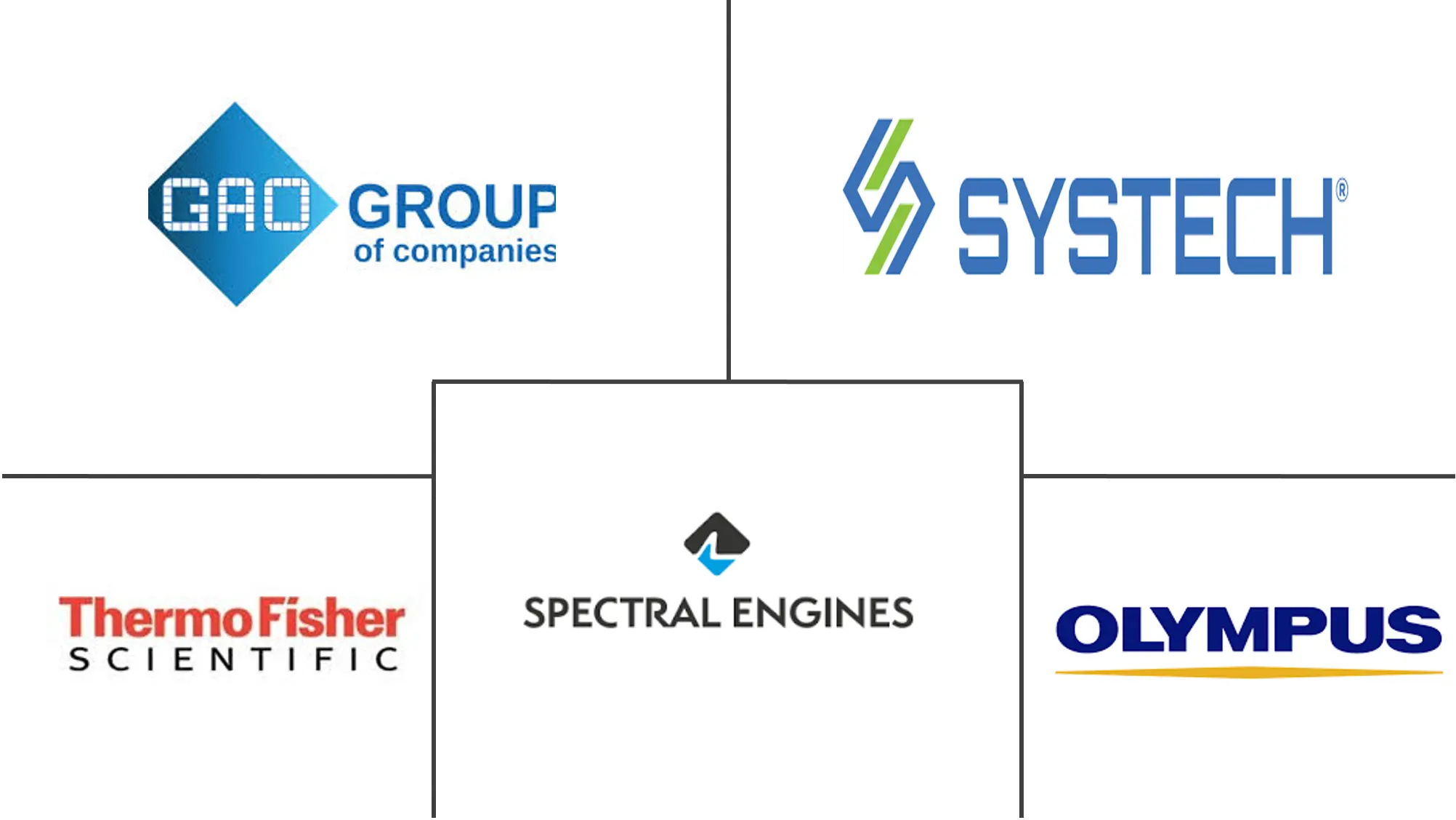Market Size of Counterfeit Drug Detection Device Industry

| Study Period | 2019 - 2029 |
| Base Year For Estimation | 2023 |
| CAGR | 4.10 % |
| Fastest Growing Market | Asia Pacific |
| Largest Market | North America |
| Market Concentration | Low |
Major Players
*Disclaimer: Major Players sorted in no particular order |
Counterfeit Drug Detection Device Market Analysis
The global counterfeit drug detection market is anticipated to witness a CAGR of 4.1% over the forecast period.
The COVID-19 pandemic significantly impacted drug manufacturing companies in its preliminary phase. The governments of several countries reported drugs and active pharmaceutical ingredients (APIs) were in short supply due to the outbreak. This was due to cross-border trade barriers that had an ultimatum effect on the import and export of medicinal products, including drugs, resulting in the rise of counterfeit medicines on the market. As per OECD updates from July 2021, the COVID-19 crisis heightened the dangers posed by the global trade in counterfeit pharmaceutical products. Health and safety issues arose when most of the population ordered falsified medicines online since these often needed to be correctly formulated and contain unsafe ingredients. Thus, tackling this global scourge became even more acute and urgent during the pandemic, boosting the use of several counterfeit drug detection devices. Moreover, as per the analysis, this amplified introduction of counterfeit drugs within the market, along with growing volumes of falsified medicines in developing countries due to a lack of stringent regulatory and standardized processes, augmented the demand for counterfeit drug detection over the post-pandemic phase.
Furthermore, the emphasis on advanced surveillance in the supply chain, the shifting trend from packaging security to on-dosage security, and supportive government legislation are some drivers bolstering the market's growth.
In addition, the rising number of counterfeit drugs is one of the major factors propelling the growth of counterfeit drug detection over the forecast period. Due to the COVID-19 pandemic, counterfeit products increased on the market owing to the crunch in the supply side of drugs. For instance, according to the WHO report, in 2021, the number of cases of substandard and falsified (SF) medical items increased by 52% from 2020. Recently, most incidents involved COVID-19-related medical products, such as vaccines, medicines, COVID test kits, antibiotics, face masks, and sanitizers. In 2021, WHO's surveillance and monitoring system for substandard and counterfeit medical products discovered fraudulent versions of the COVID-19 vaccine COVISHIELD in India and Uganda.
Moreover, a study published in May 2022 in SAGE Journals to describe the law enforcement oversight of falsified drugs by the US FDA from 2016 to 2021 stated that 130 unique enforcement actions were against counterfeiting organizations and individuals. Altogether, 64.6% of enforcement actions implicated counterfeit products marketed and sold over the internet. In 84.6% of activities, counterfeit medicines were sold without a prescription, and in 33.1% activities, the products were marketed as dietary supplements. Sexual dysfunction, anabolic muscle building, benzodiazepines, opioids, stimulants, and dermatologic drugs were the most counterfeited. China was the most predominant country to create counterfeit medicines, followed by India, Turkey, Pakistan, and Russia.
Likewise, pharmaceutical companies are incorporating counterfeit drug detection devices into their supply chains, making them more efficient and enhancing patient safety while saving time and money. For instance, in June 2022, AstraZeneca integrated RFID into its supply chain and had remarkable success dispensing over 30 million RFID-enabled Diprivan syringes.
Thus, these factors mentioned above contribute to the market's growth. However, low awareness about counterfeit drugs will likely limit the market's expansion.
Counterfeit Drug Detection Device Industry Segmentation
Counterfeit drugs are one of the most significant challenges faced by healthcare institutions and pharmaceutical manufacturers. Counterfeit drugs and medical equipment are available on a large scale, thereby hampering the goodwill of the market. As a result, there emerged a strong demand for efficient detection systems. This led to the introduction of counterfeit drug detection devices on the market. The market is segmented by technology (infrared and near-infrared spectroscopy, microfluidic (benchtop devices, and handheld devices), rapid chemical testing, Raman spectroscopy, RFID technology, and other technologies), modality (benchtop devices and handheld devices), application (chemical composition and packaging and labeling detection), and geography (North America, Europe, Asia-Pacific, Middle East and Africa, and South America). The report offers the value (USD million) for the above segments. The report also covers the estimated market sizes and trends for 17 different countries across major regions globally. The report offers the value (USD million) for the above segments.
| By Technology | |
| Infrared and Near Infrared Spectroscopy | |
| Microfluidic | |
| Rapid Chemical Testing | |
| Raman Spectroscopy | |
| RFID Technology | |
| Other Technologies |
| By Modality | |
| Benchtop Devices | |
| Handheld Devices |
| By Application | |
| Chemical Composition | |
| Packaging and Labeling Detection |
| By Geography | ||||||||
| ||||||||
| ||||||||
| ||||||||
| ||||||||
|
Counterfeit Drug Detection Device Market Size Summary
The counterfeit drug detection device market is poised for growth, driven by the increasing prevalence of counterfeit pharmaceuticals and the need for enhanced security measures in the supply chain. The COVID-19 pandemic exacerbated the issue, as supply chain disruptions led to a surge in counterfeit drugs, particularly in developing regions with less stringent regulatory oversight. This situation underscored the urgency for effective detection technologies, prompting pharmaceutical companies to integrate advanced solutions like RFID and QR codes into their operations. These technologies not only improve visibility and tracking of drugs but also enhance patient safety and streamline supply chain processes. Government regulations and supportive legislation further bolster the market, as they mandate stricter controls and encourage the adoption of innovative tracking systems.
North America is expected to dominate the market, fueled by stringent regulatory frameworks and a high incidence of drug counterfeiting. The region's pharmaceutical and biopharmaceutical sectors are increasingly adopting RFID technology for real-time asset tracking and supply chain monitoring. This trend is supported by partnerships and technological advancements from key players such as Bayer AG, Thermo Fisher Scientific Inc., and Systech International, who are actively innovating to maintain their competitive edge. The market remains fragmented, with moderate to high competition among global and regional players, driving continuous improvements and expansions in counterfeit detection technologies. As the demand for secure and reliable drug distribution systems grows, the market is anticipated to experience significant expansion over the forecast period.
Counterfeit Drug Detection Device Market Size - Table of Contents
-
1. MARKET DYNAMICS
-
1.1 Market Overview
-
1.2 Market Drivers
-
1.2.1 Emphasis on Advanced Surveillance in the Supply Chain
-
1.2.2 Shifting Trend from Packaging Security to On-dosage Security
-
1.2.3 Supportive Government Legislation
-
-
1.3 Market Restraints
-
1.3.1 Low Awareness of Counterfeit Drugs
-
-
1.4 Porter's Five Forces Analysis
-
1.4.1 Threat of New Entrants
-
1.4.2 Bargaining Power of Buyers/Consumers
-
1.4.3 Bargaining Power of Suppliers
-
1.4.4 Threat of Substitute Products
-
1.4.5 Intensity of Competitive Rivalry
-
-
-
2. MARKET SEGMENTATION (Market Size by Value - USD million)
-
2.1 By Technology
-
2.1.1 Infrared and Near Infrared Spectroscopy
-
2.1.2 Microfluidic
-
2.1.3 Rapid Chemical Testing
-
2.1.4 Raman Spectroscopy
-
2.1.5 RFID Technology
-
2.1.6 Other Technologies
-
-
2.2 By Modality
-
2.2.1 Benchtop Devices
-
2.2.2 Handheld Devices
-
-
2.3 By Application
-
2.3.1 Chemical Composition
-
2.3.2 Packaging and Labeling Detection
-
-
2.4 By Geography
-
2.4.1 North America
-
2.4.1.1 United States
-
2.4.1.2 Canada
-
2.4.1.3 Mexico
-
-
2.4.2 Europe
-
2.4.2.1 Germany
-
2.4.2.2 United Kingdom
-
2.4.2.3 France
-
2.4.2.4 Italy
-
2.4.2.5 Spain
-
2.4.2.6 Rest of Europe
-
-
2.4.3 Asia-Pacific
-
2.4.3.1 China
-
2.4.3.2 Japan
-
2.4.3.3 India
-
2.4.3.4 Australia
-
2.4.3.5 South Korea
-
2.4.3.6 Rest of Asia-Pacific
-
-
2.4.4 Middle East and Africa
-
2.4.4.1 GCC
-
2.4.4.2 South Africa
-
2.4.4.3 Rest of Middle East and Africa
-
-
2.4.5 South America
-
2.4.5.1 Brazil
-
2.4.5.2 Argentina
-
2.4.5.3 Rest of South America
-
-
-
Counterfeit Drug Detection Device Market Size FAQs
What is the current Counterfeit Drug Detection Device Market size?
The Counterfeit Drug Detection Device Market is projected to register a CAGR of 4.10% during the forecast period (2024-2029)
Who are the key players in Counterfeit Drug Detection Device Market?
Bayer AG , GAO Group , Systech International , Spectral Engines Oy and Thermo Fisher Scientific Inc. are the major companies operating in the Counterfeit Drug Detection Device Market.

